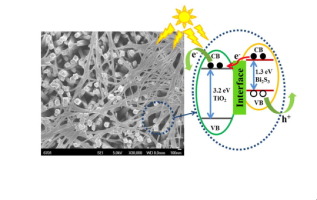Abstract: A netlike heterostructure is constructed by interlacing the Bi2S3 nanowires with well-aligned TiO2 nanorod arrays via a facile and effective solvothermal method. The winding Bi2S3 nanowires with several hundred nanometers long and 20-30 nm wide are distributed in the interspace of TiO2 nanorods and cross-linked with these nanorods reducing the isolation of nanorods. The photoelectrochemical characterizations show that in addition to the high stability in air without any encapsulation, the netlike heterostructure exhibits an enhanced photoelectrochemical performance compared with TiO2 nanorods and controlled Bi2S3/TiO2 nanoparticle structure. The dual roles of Bi2S3 nanowires (1) as sensitizer for the enlargement of photoresponse range and (2) as multiple electron transport channels facilitating the fast separation of photogenerated electron-hole pairs are considered as key factors for the high energy conversion efficiency of 2.96%. This facile synthesis method offers an attractive strategy to further improve the photoelectrochemical performance of semiconductors and undoubtedly shows promising applications in solar conversion and storage devices.

Keywords: Bi2S3 nanowires; Crystal growth; Charge transfer; Hierarchical heterostructure; Photoelectrochemical properties
Published in JOURNAL OF COLLOID AND INTERFACE SCIENCE, 481 91-99; 10.1016/j.jcis.2016.07.045 NOV 1 2016


